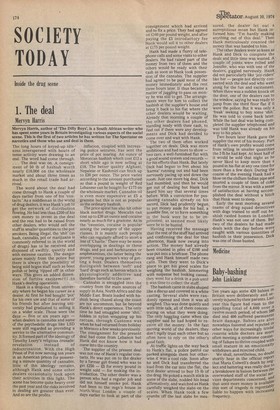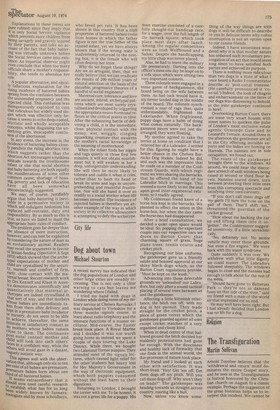Baby-bashing
John Linklater
Ten years ago some 420 babies in Britain were deliberately and se' verely injured by their parents. Last year this figure had risen to the appalling total of 4,600 over a twelve month period, of whom 58° died and 400 suffered permanent brain damage. Babies .are also nowadays fostered and rejected in other ways for increasingly trivial reasons while doctors are more often meeting a syndrome consisting of failure to thrive coupled vvith small stature in an emotionallY withdrawn and rejected child. We shall, nevertheless, no doubt shortly hear in the official report that Maria Coiwell's death by neglect and battering was really due to a breakdown in liaison between the overworked staff of the social vices departments concerned, an that until more money is available this sort of tragedy is regrettablY liable to happen with increasing frequency.
Explanations in these terms are Pure rubbish since they imply that it is only Social Service vigilance which prevents more children from being savagely and gravely injured by their parents, and take no ac count of the fact that baby battering was virtually unknown before the Social Services came into exis tence. An impartial observer might even conclude that when too many Officials share a mother's responsibility, she tends to abandon her role.
A popular alternative, and equally fallacious, explanation for the rising incidence of battered babies sprang from the confusion between the unintended pregnancy and the rejected child. This confusion was disingenuously exploited to coin that ridiculous but widely used slo gan which was effective only be cause it seems to echo deep-rooted, atavistic and wholly acceptable concepts, whilst disguising the underlying grim, inescapable conclusion of the abortionist.
In any event, the increase in the incidence of battering babies close ly parallels the riding abortion rate Which suggests rather that the Abortion Act encourages a ruthless attitude towards the troublesome infant or else that social abortion and baby battering are both equally the manifestations of some other common cause; shortage of housing, poverty and lack of education have all been somewhat unconvincingly suggested. We may, of course, justifiably argue that baby-battering is inevi table in a permissive society in Which self-indulgent hedonism has replaced self-restraint, duty, and responsibility. By as much as this is true, so have we failed to instil the appropriate basic rules.of conduct. The problem goes far deeper than the absence of mere instruction, however, and can best be explained by considering the nature of man as an evolutionary animal. Readers may recall the arguments in favour
Of breast-feeding (Spectator, 8 Sept 1973) which showed that the arche typal expectations of mother and child are crystallised by the security, warmth and comfort of firm, early, close contact with the ma
ternal breast. Recent research work bY Drs Kennell and Klaus in Amer
ica demonstrates scientifically and quantitatively that maternal archetypes are indeed crystallised in that sort of way, and that mothers whose babies are immediately taken from them after delivery and kept in a premature baby incubator or nursery, do not seem to be able to achieve, thereafter, the same intimate or satisfactory contact as dO mothers whose babies remain Close to them. The continuous Post-natal contact mother and Child will look into each others' faces in a confident way, while the others will avoid gaze in a distant, vaguely autistic way.
This agrees well with the observation that, although only six to ten Per cent of all babies are premature, Premature babies form about one third of all battered babies. . It seems extraordinary that it ,should now need careful research !.0 establish what has for so long °een widely known by farmers, zo chogists and by most schoolboys, who breed pet rats. It has been shown in this country that a high proportion of battered babies come from homes in which the father figure is not the true father of the injured infant, yet we have always known that if the wrong mate is inadvertently returned to the nesting box, it is the female who will often destroy her litter.
Why do we forget these things? Are we so arrogant, then, that we really believe that we can eradicate the results of 200 million years of natural selection on the basis of the plausible, progressive theories of a handful of social engineers?
Maternal care, tolerance and love are ancient, inbred, archetypal patterns which are most surely crystallised and developed by triggering the appropriate neuro-hormonal reflexes at the critical points in time. After the exhausting battle of delivering a child, it is the immediate, close, physical contact with the messy, wet, wriggly., clinging squawking creature that awakens the mother's racial knowledge of the meaning of motherhood.
When the infant finds her nipple and tugs quietly in those first few minutes, it will not obtain nourishment but it will awaken in her a deep, unforgettable understanding. She will then be more likely to tolerate and cuddle it when it cries, rather than to bash its head or break its arms and legs in uncomprehending and resentful frustration. Nor will she hand it over so readily to a social worker when life becomes stressful. The incidence of rejected babies is therefore yet another example of the way in which society in its collective adolescence is attempting to defy the archetype.

































 Previous page
Previous page